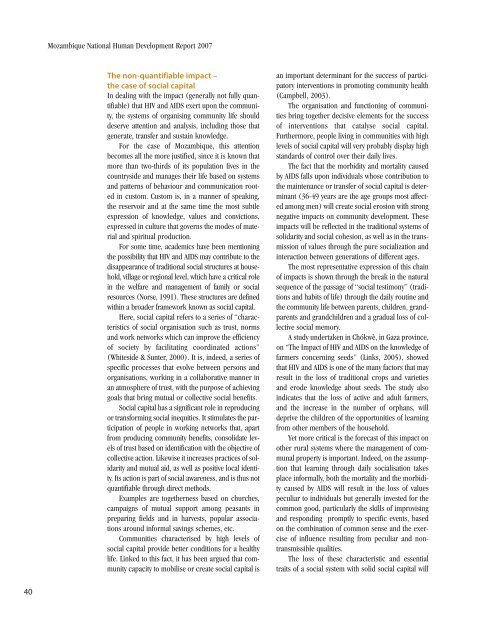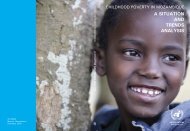English language version - Human Development Reports - United ...
English language version - Human Development Reports - United ...
English language version - Human Development Reports - United ...
- No tags were found...
You also want an ePaper? Increase the reach of your titles
YUMPU automatically turns print PDFs into web optimized ePapers that Google loves.
Mozambique National <strong>Human</strong> <strong>Development</strong> Report 2007The non-quantifiable impact –the case of social capitalIn dealing with the impact (generally not fully quantifiable)that HIV and AIDS exert upon the community,the systems of organising community life shoulddeserve attention and analysis, including those thatgenerate, transfer and sustain knowledge.For the case of Mozambique, this attentionbecomes all the more justified, since it is known thatmore than two-thirds of its population lives in thecountryside and manages their life based on systemsand patterns of behaviour and communication rootedin custom. Custom is, in a manner of speaking,the reservoir and at the same time the most subtleexpression of knowledge, values and convictions,expressed in culture that governs the modes of materialand spiritual production.For some time, academics have been mentioningthe possibility that HIV and AIDS may contribute to thedisappearance of traditional social structures at household,village or regional level, which have a critical rolein the welfare and management of family or socialresources (Norse, 1991). These structures are definedwithin a broader framework known as social capital.Here, social capital refers to a series of “characteristicsof social organisation such as trust, normsand work networks which can improve the efficiencyof society by facilitating coordinated actions”(Whiteside & Sunter, 2000). It is, indeed, a series ofspecific processes that evolve between persons andorganisations, working in a collaborative manner inan atmosphere of trust, with the purpose of achievinggoals that bring mutual or collective social benefits.Social capital has a significant role in reproducingor transforming social inequities. It stimulates the participationof people in working networks that, apartfrom producing community benefits, consolidate levelsof trust based on identification with the objective ofcollective action. Likewise it increases practices of solidarityand mutual aid, as well as positive local identity.Its action is part of social awareness, and is thus notquantifiable through direct methods.Examples are togetherness based on churches,campaigns of mutual support among peasants inpreparing fields and in harvests, popular associationsaround informal savings schemes, etc.Communities characterised by high levels ofsocial capital provide better conditions for a healthylife. Linked to this fact, it has been argued that communitycapacity to mobilise or create social capital isan important determinant for the success of participatoryinterventions in promoting community health(Campbell, 2003).The organisation and functioning of communitiesbring together decisive elements for the successof interventions that catalyse social capital.Furthermore, people living in communities with highlevels of social capital will very probably display highstandards of control over their daily lives.The fact that the morbidity and mortality causedby AIDS falls upon individuals whose contribution tothe maintenance or transfer of social capital is determinant(36-49 years are the age groups most affectedamong men) will create social erosion with strongnegative impacts on community development. Theseimpacts will be reflected in the traditional systems ofsolidarity and social cohesion, as well as in the transmissionof values through the pure socialization andinteraction between generations of different ages.The most representative expression of this chainof impacts is shown through the break in the naturalsequence of the passage of “social testimony” (traditionsand habits of life) through the daily routine andthe community life between parents, children, grandparentsand grandchildren and a gradual loss of collectivesocial memory.A study undertaken in Chókwè, in Gaza province,on “The Impact of HIV and AIDS on the knowledge offarmers concerning seeds” (Links, 2005), showedthat HIV and AIDS is one of the many factors that mayresult in the loss of traditional crops and varietiesand erode knowledge about seeds. The study alsoindicates that the loss of active and adult farmers,and the increase in the number of orphans, willdeprive the children of the opportunities of learningfrom other members of the household.Yet more critical is the forecast of this impact onother rural systems where the management of communalproperty is important. Indeed, on the assumptionthat learning through daily socialisation takesplace informally, both the mortality and the morbiditycaused by AIDS will result in the loss of valuespeculiar to individuals but generally invested for thecommon good, particularly the skills of improvisingand responding promptly to specific events, basedon the combination of common sense and the exerciseof influence resulting from peculiar and nontransmissiblequalities.The loss of these characteristic and essentialtraits of a social system with solid social capital will40
















